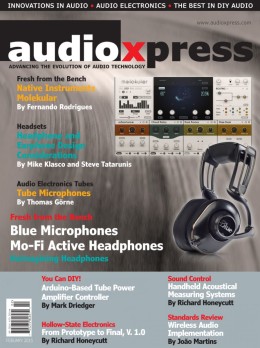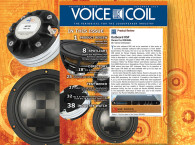
Our cover highlights two reviews, starting with the daring Blue Microphones’ Mo-Fi Active Headphones. The Mo-Fi headphones are Blue Microphones first entry into a crowded product category and are a circumaural closed-back configuration with an onboard headphone amplifier. As we explain, Blue Microphones’ product development team took some design risks and audioXpress couldn’t find the target-user for Blue Microphones’ design. Some succeeded while other aspects are, let’s just say, “not mature,” but we found the Mo-Fi certainly “gets points for attempting a lot of innovative design choices.”
Our second review features an unexpected development from Zynaptiq CEO Denis H. Goekdag for Native Instruments. Its new creation, Molekular, was noticed by our expert software reviewer Fernando Rodrigues who follows closely the work of some of the most brilliant minds in the music industry today. As Fernando explains, “in the crowded world of plug-ins, every once in a while something stands out due to its uniqueness and originality.” “Molekular is difficult to categorize. It certainly is aimed at audio processing, but its uniqueness and complexity makes it much more than that. It’s a powerful tool for sound design and sound creation, and its modularity offers an immense world of possibilities.” We have no doubt this review will influence many of our readers to follow closer the fascinating world of audio software engineering, one of the most innovative areas in the industry today.
Our monthly columns include the continuation of Ron Tipton’s experiments in the world of realistic recorded sound reproduction, this month exploring Dolby Laboratories’ early success with surround sound. Our Wireless Audio column is dedicated to wireless audio implementation platforms — especially interesting to developers and anyone considering designing wireless audio products. Mike Klasco’s Nordic Audio Tales series returns this month, featuring Peter and Dorit Larsen’s LOUDSOFT and the many audio advancements made possible by their company. Mike Klasco and Steve Tatarunis’ series of articles about Headsets examines headphone and earphone product development process.
We also feature an excellent article from a reputed professional and audio expert, Thomas Görne. His original article about “Tube Microphones” was published some years ago in German and audioXpress translated his work, revisiting historical tube condenser microphones and explaining why they remain some of the most desirable studio equipment in existence.
Richard Honeycutt’s Sound Control column starts reviewing Handheld Acoustical Measuring Systems, which can be classed as handheld systems, desktop or laptop computer-based systems, and personal-device-based systems. This month, he examines NTi Audio’s AL1 and XL2 handheld acoustical measurement systems.
For our readers interested in industry examples and inspirational stories, Shannon Becker interviews Forte founders Scott Chen and Travis Blane. Forte is an innovative headphone company with a strong range of products recently launched in the market. Forte’s headphones use Harmonic Interference Free (HIF) Technology, which is solely based on fundamental physics principles and advanced mathematical calculations to reduce and better eliminate harmonic interference. As they explain, it all started with “extracting the sound of a bullfrog from a noisy recording of the surrounding forest mountain and waterfall…”
For our DIY enthusiasts, we feature a modern take on a popular audio electronics project. Mark Driedger explains how to use a common open-source microcontroller module, the Arduino, to build an automatic power controller for a tube power amplifier.
In our Hollow-State Electronics article, Richard Honeycutt details the modifications needed to take a distortion pedal design project from the prototype to a more-or-less finished product. “From Prototype to Final” looks at a practical project and how to address different improvement stages, learning to think like an expert-designer.
As usual, your new issue of audioXpress is now available at www.gotomyxpress.com
To become a member, visit www.audioxpress.com/page/audioXpress-Subscription-Services.html.
You can also buy a single printed issue at /www.cc-webshop.com








